
The numbers tell the tale: Without adequate water, tomato yields around Leamington, Ont., run about 30 to 35 tons per acre. If growers ensure sufficient moisture is applied to the plants, these yields can be boosted to 50 to 60 tons per acre. More importantly, a reliable water supply improves the chances of a bumper tomato crop.
The numbers tell the tale: Without adequate water, tomato yields around
Leamington, Ont., run about 30 to 35 tons per acre. If growers ensure
sufficient moisture is applied to the plants, these yields can be
boosted to 50 to 60 tons per acre. More importantly, a reliable water
supply improves the chances of a bumper tomato crop.
The moral of this tale? For Leamington tomato farmers who rely on
nearby H.J. Heinz and Sun-Brite (Sun-Brite, Primo and Unico brands)
processing plants to buy their crops, water matters.
This is why 13 Leamington farmers – spearheaded by Wayne Palichuk of
Palichuk Farms – came together about five years ago to form Leamington
Area Drip Irrigation (LADI) Incorporated. Other members include Tiessen
Farms, Lehn Farms, Len Driedger, Ken Hamm, Pete Brunatto, Glen and Todd
Waites, Greg Dick, Lycoland Farms, Stasko Farms, Ken Epp, Triple K
Farms and Tom Dick.
LADI’s mission was to build a 40-kilometre pipeline from Lake Erie to
the farms of LADI members. By doing so, the issue of reliable water
would finally be solved, resulting in higher tomato yields, more secure
farmer operations, and a solid reason for Heinz and Sun-Brite to
maintain their plants here.
It took $6 million – $1.9 million from the federal government; the rest
raised by mortgages on the farmers’ properties – to pay for the
project. But the expense was worth it: At press time, LADI’s dream had
become reality. “The pipeline is in place, and the water has been
flowing at a 60 to 70 per cent capacity to flush out the system and to
help us catch any bugs,” says Palichuk; LADI’s chairman. “But the
system works; there’s no doubt about it.”
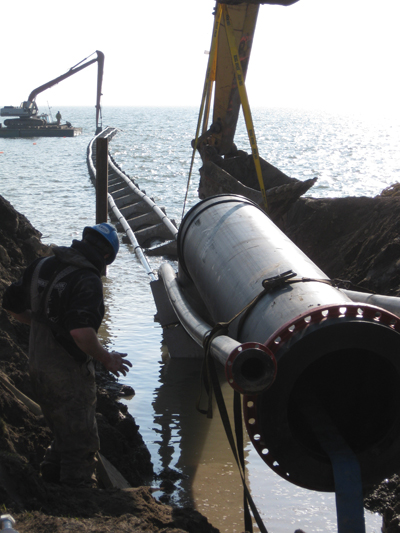 |
|
| The Leamington Area Drip Irrigation (LADI) Incorporated irrigation pipeline starts 400 feet out from the north shore of Lake Erie, at the Erie Shores Golf and Country Club. Submitted photos |
|
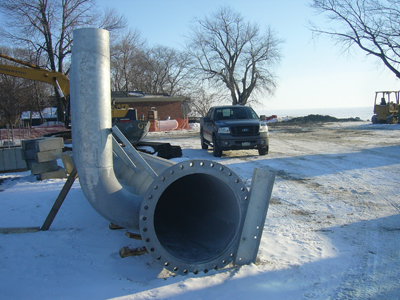 |
|
| The LADI pipe can deliver up to 6,300 gallons per minute to fields but the system will only need to run at 5,600 gpm to serve the organization’s current member farms. |
|
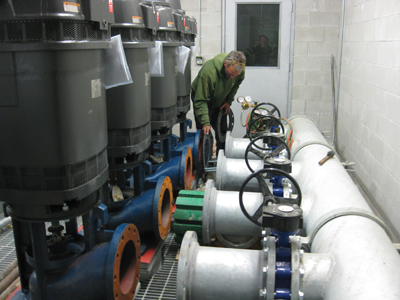 |
|
| Four 150 hp electric pumps bring the water to the main pump house of the system. At this point, the water is chlorinated to keep zebra mussels from blocking the pipeline.Four 150 hp electric pumps bring the water to the main pump house of the system. At this point, the water is chlorinated to keep zebra mussels from blocking the pipeline. |
|
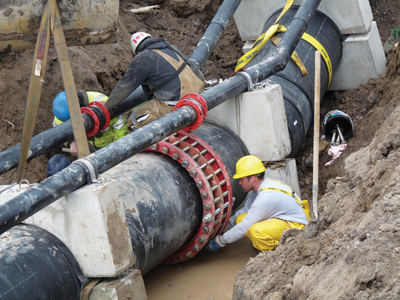 |
|
| Work crews connect sections of the Leamington Area Drip Irrigation (LADI) Incorporated irrigation pipeline during construction. |
|
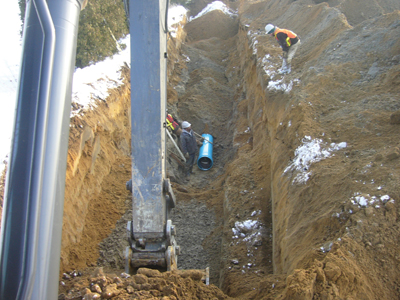 |
|
| All the piping is buried below frost level to ensure there are no problems with freezing during the cold winter months. |
|
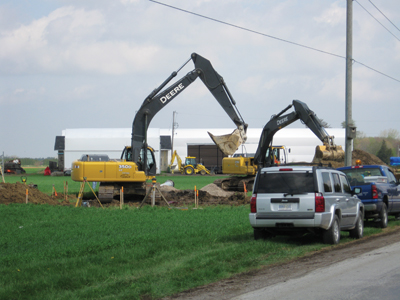 |
|
| To provide water to farmers, 63 “taps” have been installed along the pipeline’s run. Each of these taps can connect to three more service lines. |
LADI’s architecture
The LADI irrigation pipeline starts 400 feet out from the north shore
of Lake Erie, at the Erie Shores Golf and Country Club. “We have a
36-foot diameter pipe with screening on the lake bottom, which draws
water back to a pumping station that is co-located with the golf and
country club,” Palichuk says. “We have four, 150 hp electric pumps that
bring the water to our main pump house. At this point, the water is
chlorinated to keep zebra mussels from blocking the pipeline.”
From the main pumphouse, LADI’s water travels northwards by 24-foot
pipe to 6,000 acres around Leamington. Its flow is boosted along the
way by two pumping stations. By the time it makes it to the end of the
pipeline at Mersea Road 7, the diameter has been reduced to six inches
to maintain pressure.
All the piping is buried below frost level to ensure there are no
problems with freezing during the cold winter months. To provide water
to farmers, 63 “taps” have been installed along the pipeline’s run; the
taps’ pipes go vertically from the surface down to the main pipe. Each
of these taps can connect to three more service lines. Once connected
to drip irrigation systems, the LADI pipe can deliver up to 6,300
gallons per minute to thirsty fields. However, the system will only
need to run at 5,600 gpm to serve LADI’s member farms. Typically, it
will only serve 1,500 to 2,000 acres at any given time.
Keeping within the rules
It doesn’t take much effort to spot examples of over-irrigation around
the world. The most notorious can be seen at Russia’s Aral Sea. Thanks
to the diversion of too much water to irrigation canals, the once
68,000 sq. km. sea had shrunk to 25 per cent of its original size by
2004. Photos of rusting fishing trawlers lying on dry grasslands – the
remains of the dried-up seabed – have become iconic symbols of what
happens when irrigation goes too far.
Closer to home, the abundance of Canada’s fresh water supply has become
a political issue. For farmers like those belonging to LADI, getting
the water they need without running afoul of environmentalists required
restraint and good judgement.
Fortunately, that’s exactly what their project displayed. By only using
a 36-inch inlet pipe and utilizing drip technology that doesn’t lose
water to evaporation – either in the system on when delivered to plants
on the ground – LADI won the blessing of politicians at all levels of
government. According to the Canadian Environmental Assessment Agency,
which reviewed the project, “the authority is of the opinion that the
project is not likely to cause significant adverse environmental
effects.”
“We take the impact on our local water resources very seriously,” says
Palichuk. “In fact, one reason we wanted this project was so that we
could stop using Leamington’s municipal water supply, which has been
suffering shortages due to all the demand. Now, we are off that system,
and using no more than 20 gallons per minute per acre thanks to the
drip method. To put this another way, an area that receives four hours
of dripped water every day for seven days gets the equivalent of one
inch of water. That’s within the guidelines that cities are
recommending to residents for watering their lawns responsibly.”
Impact
The LADI project shows what farmers can do when they work together to
solve a problem. It also illustrates that, contrary to many urban
stereotypes, farmers are up-to-date on the latest environmentally
responsible technology, and how it can be used to improve crop
productivity without hurting the planet.
In this instance, Leamington-area farmers are not only benefitting
themselves, but the entire community. Creating their own water supply
reduces demand on Leamington’s municipal system at a time when
construction costs are climbing, population is increasing, and tax
revenues are uncertain. Ensuring a reliable source of local tomatoes
motivates processors like Heinz and Sun-Brite to stay in the community;
protecting the estimated 1,000 jobs that these plants create. In turn,
those jobs help keep the rest of Leamington’s economy alive; something
that is especially important during a recession.
The 13 farmers who formed LADI didn’t set out to do all this; they just
wanted to finally resolve a decades-old water shortage that has long
plagued their industry. But now that LADI is here, everyone in the
Leamington area is benefitting from the pipeline, without compromising
the reservoir of water that keeps Lake Erie and the rest of the Great
Lakes viable and alive.
“LADI is a great example of what can be done when people come
together,” concludes Palichuk. “And it sure is a comfort when the rains
don’t come – not this summer, perhaps, but in the years ahead.”
Print this page